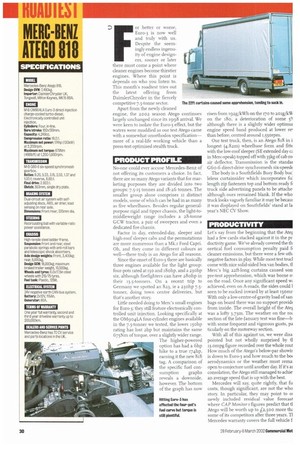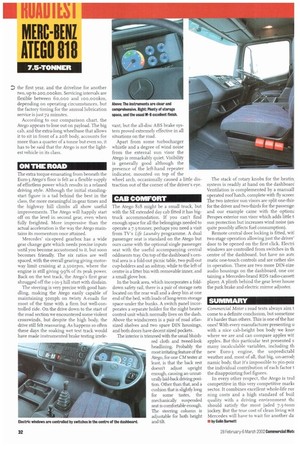D or better or worse,
Page 30

Page 32

If you've noticed an error in this article please click here to report it so we can fix it.
Euro-3 is now well and truly with us. Despite the seemingly endless ingenuity of engine designers, sooner or later there must come a point where cleaner engines become thirstier engines. Where this point is depends on who you listen to. This month's roadtest tries out the latest offering from DaimlerChrysler in the fiercely competitive 7.5-tonne sector.
Apart from the newly cleaned engine, the 2002 season Atego largely unchanged since its 1998 arrival. We were keen to isolate the Euro-3 effect, but the waters were muddied as our test Atego came with a somewhat unorthodox specification— more of a real-life working vehicle than a press-test optimised stealth truck.
continues
PRODUCT PROFILE
No-one could ever accuse Mercedes-Benz of not offering its customers a choice. In fact, there are so many Atego variants that for marketing purposes they are divided into two groups: 7.5-15 tonnes and 18-26 tonnes. The smaller group alone comprises ti distinct models, some of which can be had in as many as five wheelbases. Besides regular generalpurpose rigid and tipper chassis, the light-tomiddleweight range includes a 28-tonne GCW tractor, a pair of sweepers and even a dedicated fire chassis.
Factor in day, extended-day, sleeper and high-roof sleeper cabs and the permutations are more numerous than a Mk.r Ford Capri. Oh, and they come in different colours as well—there truly is an Atego for all reasons.
Since the onset of Euro-3 there are basically three engines available for the light group: four-pots rated at 150 and r8ohp, and a 23ohp six, although firefighters can have 28ohp in their 9.5-tormers. On a recent trip to Germany we spotted an 823, le a 2,3ohp 7.5tonner, doing town centre deliveries, but that's another story.
Little needed doing to Merc's small engines for Euro.3; they still feature electronically con trolled unit injection. Looking specifically at the 0M9 04 LA four.cylinder engines available in the 7.5-tonner we tested, the lower 15ohp rating has lost zhp but maintains the same 675Nm of torque, over a slightly wider range. The higher-powered option has had a 6hp hike to a true 174hp, earning it the new 818 tag. A comparison of the specific fuel consumption graphs reveals a downside, however. The bottom of the graph has now risen from r92g/kWh on the 170 to 201g/kW on the /8o, a deterioration of some 59 although there is a slightly wider optimui engine speed band produced at lower rel than before, centred around 1,550rpm.
Our test truck, then, is an Atego 818 in i longest (4.82m) wheelbase form and fiat with the low-roof sleeper (SE extended day ca. in Merc-speak) topped off with 35kg of cab ra air deflector. Transmission is the standai G6o-6 direct-drive synchromesh six-speedc
The body is a Southfields Busy Body buC leless curtainsider which incorporates fill length zip fasteners top and bottom ready fl truck side advertising panels to be attache although ours remained blank. If the who truck looks vaguely familiar it maybe becate it was displayed on Southfields' stand at la year's NEC CV Show.
PRODUCTIVITY
Let's say from the beginning that the Ate had a few cards stacked against it in the pr ductivity game. We've already covered the th oretical fuel consumption penalty paid fi cleaner emissions, but there were a few oth, negative factors in play. While most test trucl come with nice solid-sided box van bodies, ti Merc's big 22ft-long curtains caused son pre-test apprehension, which was borne o; on the road. Once any significant speed w; achieved, even on A-roads, the sides could I seen to be sucked inward by at least r5omr With only a low-centre-of-gravity load of san bags on board there was no support providc from inside. The overall height of the Atei was a lofty 3.73m. The weather on the roz section of the late-January test was fine—b with some frequent and vigorous gusts, pa ticularly on the motorway section.
With all of this against us, we were disa pointed but not wholly surprised by ti 13.0mpg figure recorded over the whole rout How much of the Atego's below-par showir is down to Euro-3 and how much to the boc aerodynamics or the weather must rema open to conjecture until another day. If it's ai consolation, the Atego still managed to achie an average speed that is up with the best.
Mercedes will say, quite rightly, that fu costs, though significant, are not the who story In particular, they may point to oi newly included residual value forecasi where CAP Monitors figures predict that ti Atego will be worth up to f2,5oo more thz some of its competitors after three years. Ti Mercedes warranty covers the full vehide f
the first year, and the driveline for another two, up to 200,000km. Servicing intervals are flexible between Go,000 and ioo,000km, depending on operating circumstances, but the factory timing for the annual lubrication service is just 72 minutes.
According to our comparison chart, the Atego appears to lose out on payload. The big cab, and the extra-long wheelbase that allows it to sit in front of a zoft body, accounts for more than a quarter of a tonne but even so, it has to be said that the Atego is not the lightest vehicle in its dass.
ON THE ROAD
The extra torque emanating from beneath the Euro-3 Atego's floor is felt as a flexible supply of effortless power which results in a relaxed driving style. Although the initial standingstart figure is a tad behind the best in the class, the more meaningful in-gear times and the highway hill climbs all show useful improvements. The Atego will happily start off on the level in second gear, even when fully freighted. More impressive than the actual acceleration is the way the Atego maintains its momentum once attained.
Mercedes' six-speed gearbox has a wide gear change gate which needs precise inputs until you become accustomed to it, but soon becomes friendly. The six ratios are well spaced, with the overall gearing giving motorway limit cruising at 2.300 rpm. where the engine is still giving 99% of its peak power. Back on the test track, the Atego's first gear shrugged off the hill start with disdain.
The steering is very precise with good handling, making the Atego easily capable of maintaining 50mph on twisty A-roads for most of the time with a firm but well-controlled ride. On the drive down to the start of the road section we encountered some violent crosswinds, but despite the high body, the drive still felt reassuring. As happens so often these days the soaking wet test track would have made instrumented brake testing irrele vant, but the all-disc ABS brake system proved extremely effective in all situations on the road.
Apart from some turbocharger whistle and a degree of wind noise from the external sun visor the Atego is remarkably quiet. Visibility is generally good although the presence of the left-hand repeater indicator, mounted on top of the wheel arch, occasionally caused a little distraction out of the corner of the driver's eye.
CAB comronT
The Atego 818 might be a small truck, but with the SE extended day cab fitted it has bigtruck accommodation. If you can't find enough space for all the belongings needed to operate a 7.5-tonner, perhaps you need a visit from TV's Life Laundry programme. A dual passenger seat is standard on the Atego but ours came with the optional single passenger seat with the useful accompanying central oddments tray. On top of the dashboard's central area is a fold-out picnic table, two pull-out cup-holders and an ashtray, while to the left of centre is a litter bin with removable inner, and a small glove box.
In the bunk area, which incorporates a folddown safety rail, there is a pair of storage nets located on the rear wall and a deep bin at one end of the bed, with loads of long-term storage space under the bunks. A switch panel incorporates a separate holder for the night heater control unit which normally lives on the dash. Above the windscreen is a pair of road atlassized shelves and two spare DIN housings, and both doors have decent sized pockets.
The interior is trimmed with the usual bluishred cloth and tweed-look headlining. Probably the most irritating feature of the Atego, for one CM tester at least, is that the back rest doesn't adjust upright enough, causing an unnaturally laid-back driving position. Other than that, and a cushion that is slightly long for some tastes, the mechanically suspended seat is comfortable enough. The steering column is adjustable for both height and tilt.
The stack of rotary knobs for the heatinl system is readily at hand on the dashboard Ventilation is complemented by a manuall operated roof hatch, complete with fly screer The two interior sun visors are split one-thirl for the driver and two-thirds for the passenge and our example came with the optiona Perspex exterior sun visor which adds little t, sun protection but increases wind noise (an, quite possibly affects fuel consumption).
Remote central door locking is fitted, wit] two-stage operation allowing just the driver' door to be opened on the first click. Electri windows are controlled from switches in th centre of the dashboard, but have no autc matic one-touch controls and are rather slol in operation. There are two more DIN-size audio housings on the dashboard, one cor taming a Mercedes-brand RDS radio-cassett player. A plinth behind the gear lever house the park brake and electric mirror adjuster.
SUMMARY
Commercial Motor s road tests always aim t come to a definite conclusion, but sometime it's harder than others. This is one of the har ones! With every manufacturer presenting u with a nice cab-height box body we knol where we are and can compare apples wit apples. But this particular test presented s many incalculable variables, including th new Euro-3 engine, the unpredictabl weather and, most of all, that big, un-aerod] namic body, that it's impossible to pin-poir the individual contribution of each factor t the disappointing fuel figures.
In every other respect, the Atego is trul competitive in this very competitive markt sector. It combines excellent whole-life rur ning costs and a high standard of buil quality with a driving environment tht should satisfy the most jaded 7.5-tonn jockey. But the true cost of clean living wit Mercedes will have to wait for another cla
• by Cob Barnett












































































































































